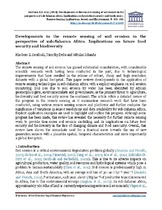| dc.contributor.author | Seutloali, Khoboso E. | |
| dc.contributor.author | Dube, Timothy | |
| dc.contributor.author | Sibanda, Mbulisi | |
| dc.date.accessioned | 2018-04-20T12:49:24Z | |
| dc.date.available | 2018-04-20T12:49:24Z | |
| dc.date.issued | 2018 | |
| dc.identifier.citation | Seutloali, K.E. et al. (2018). Developments in the remote sensing of soil erosion in the perspective of sub-Saharan Africa. Implications on future food security and biodiversity. Remote Sensing Applications: Society and Environment, 9: 100–106. | en_US |
| dc.identifier.issn | 2352-9385 | |
| dc.identifier.uri | http://dx.doi.org/10.1016/j.rsase.2017.12.002 | |
| dc.identifier.uri | http://hdl.handle.net/10566/3606 | |
| dc.description.abstract | The remote sensing of soil erosion has gained substantial consideration, with considerable scientific research work having been conducted in the past, due to technological improvements that have resulted in the release of robust, cheap and high resolution datasets with a global foot-print. This paper reviews developments in the application of remote sensing technologies in sub-Saharan Africa with a explicit emphasis on soil erosion monitoring. Soil loss due to soil erosion by water has been identified by African geomorphologists, environmentalists and governments, as the primary threat to agriculture, biodiversity and food security across the continent. The article offers a detailed review of the progress in the remote sensing as it summarises research work that have been conducted, using various remote sensing sensors and platforms and further evaluates the significance of variations in sensor resolutions and data availability for sub-Saharan Africa. Explicit application examples are used to highlight and outline this progress. Although some progress has been made, this review has revealed the necessity for further remote sensing work to provide time-series soil erosion modelling and its implications on future food security and biodiversity in the face of changing climate and food insecurity. Overall, this review have shown the immediate need for a drastical move towards the use of new generation sensors with a plausible spatial, temporal characteristics and more importantly a global foot-print. | en_US |
| dc.language.iso | en | en_US |
| dc.publisher | Elsevier | en_US |
| dc.rights | This is the author-version of the article published online at: http://dx.doi.org/10.1016/j.rsase.2017.12.002 | |
| dc.subject | Mapping | en_US |
| dc.subject | Detection | en_US |
| dc.subject | Satellite data | en_US |
| dc.subject | Spatial resolutions | en_US |
| dc.title | Developments in the remote sensing of soil erosion in the perspective of sub-Saharan Africa. Implications on future food security and biodiversity | en_US |
| dc.type | Article | en_US |
| dc.privacy.showsubmitter | FALSE | |
| dc.status.ispeerreviewed | TRUE | |

